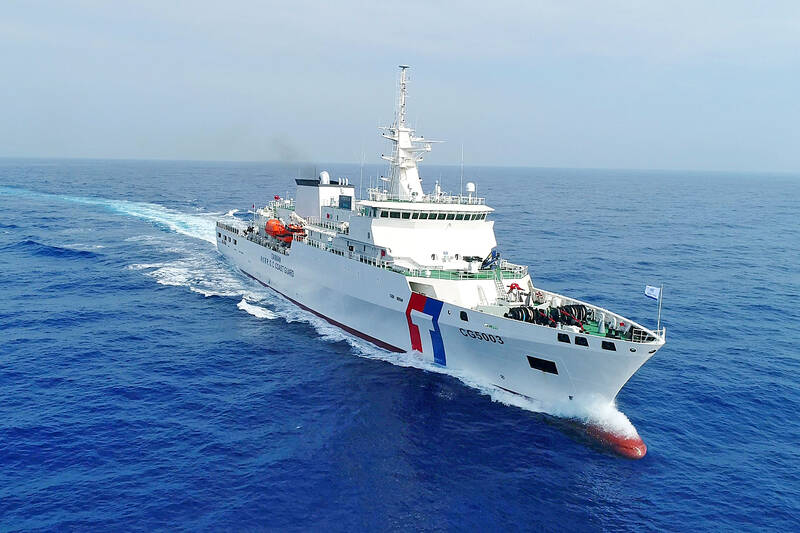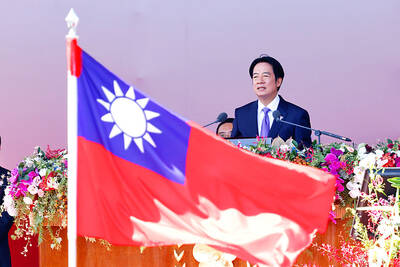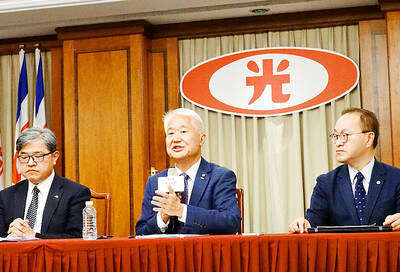Taiwan and Japan are moving to normalize joint coast guard training and considering the inclusion of other allies, the Japanese Yomiuri Shimbun reported yesterday.
Both nations’ coast guards in June sent vessels to the seas south of the Sakishima Islands to conduct joint training, the report said, adding that it was the second joint maritime training exercise since the nations severed formal diplomatic ties in September 1972.
Japan dispatched the Nagoya Coast Guard’s Mizuho, a 134m, 6,000-tonne patrol vessel which can carry a helicopter, while the Coast Guard Administration (CGA) sent the 126m, 4,000-tonne Yunlin, one of its largest vessels, the report said.

Photo courtesy of the Coast Guard Administration
The vessels came close enough to visually identify each other and shared information to coordinate their operations, before the Mizuho continued on to conduct a joint training exercise with Malaysia, the report said.
The two nations’ coast guards also conducted a joint search-and-rescue exercise in waters south of Japan’s Boso Peninsula in July last year, it said, adding that Tokyo classifies this type of joint training as an exchange activity under memorandums of understanding (MOUs) related to maritime rescue, which were signed in 2017 and last year.
The two nations’ coast guards have also held private exchanges in Taipei and Tokyo over the past few years, deepening their collaboration, the report said.
The two sides are boosting cooperation in response to China’s increasing coercive actions in the East and South China seas, and waters around Taiwan, it said.
In Taipei, in response to media queries, the CGA yesterday said that Taipei and Tokyo representatives routinely collaborate on ocean governance under the Taiwan-Japan Maritime Affairs Cooperation Dialogue.
The two nations have also signed MOUs on issues such as search-and-rescue at sea and efforts to combat smuggling, in addition to other routine collaboration, the CGA said.
The joint exercise in June exemplified the kind of bilateral cooperation made possible by the dialogue, it said.
The Japan-Taiwan Exchange Association — whose Taipei office is Japan’s de facto embassy in Taiwan — had requested the Japan Coast Guard to hold the joint drills, which the latter granted, it said.
Sources said that the CGA employs liaison personnel in Tokyo and Naha in Japan, the Philippines and Indonesia to facilitate search-and-rescue missions and resolve fishing disputes.
The CGA has conducted joint patrols and exercises with counterparts in the US, Japan and Palau, but officials consistently downplay these activities to avoid political controversy, they said.
Taiwan-flagged offshore patrol vessels have been pictured refitting in harbor facilities at Tokyo Bay, the sources added.
Commenting on the report, Ocean Affairs Council Minister Kuan Bi-ling (管碧玲) yesterday said: “We are gladdened by Japan’s willingness to disclose [bilateral cooperations].”
The joint exercises are commonly conducted in waters to the north of Japan, south of the Philippines and the South China Sea, she added.
Additional reporting by Feng Wei-li

People can preregister to receive their NT$10,000 (US$325) cash distributed from the central government on Nov. 5 after President William Lai (賴清德) yesterday signed the Special Budget for Strengthening Economic, Social and National Security Resilience, the Executive Yuan told a news conference last night. The special budget, passed by the Legislative Yuan on Friday last week with a cash handout budget of NT$236 billion, was officially submitted to the Executive Yuan and the Presidential Office yesterday afternoon. People can register through the official Web site at https://10000.gov.tw to have the funds deposited into their bank accounts, withdraw the funds at automated teller

PEACE AND STABILITY: Maintaining the cross-strait ‘status quo’ has long been the government’s position, the Ministry of Foreign Affairs said Taiwan is committed to maintaining the cross-strait “status quo” and seeks no escalation of tensions, the Ministry of Foreign Affairs (MOFA) said yesterday, rebutting a Time magazine opinion piece that described President William Lai (賴清德) as a “reckless leader.” The article, titled “The US Must Beware of Taiwan’s Reckless Leader,” was written by Lyle Goldstein, director of the Asia Program at the Washington-based Defense Priorities think tank. Goldstein wrote that Taiwan is “the world’s most dangerous flashpoint” amid ongoing conflicts in the Middle East and Russia’s invasion of Ukraine. He said that the situation in the Taiwan Strait has become less stable

CONCESSION: A Shin Kong official said that the firm was ‘willing to contribute’ to the nation, as the move would enable Nvidia Crop to build its headquarters in Taiwan Shin Kong Life Insurance Co (新光人壽) yesterday said it would relinquish land-use rights, or known as surface rights, for two plots in Taipei’s Beitou District (北投), paving the way for Nvidia Corp to expand its office footprint in Taiwan. The insurer said it made the decision “in the interest of the nation’s greater good” and would not seek compensation from taxpayers for potential future losses, calling the move a gesture to resolve a months-long impasse among the insurer, the Taipei City Government and the US chip giant. “The decision was made on the condition that the Taipei City Government reimburses the related

FRESH LOOK: A committee would gather expert and public input on the themes and visual motifs that would appear on the notes, the central bank governor said The central bank has launched a comprehensive redesign of New Taiwan dollar banknotes to enhance anti-counterfeiting measures, improve accessibility and align the bills with global sustainability standards, Governor Yang Chin-long (楊金龍) told a meeting of the legislature’s Finance Committee yesterday. The overhaul would affect all five denominations — NT$100, NT$200, NT$500, NT$1,000 and NT$2,000 notes — but not coins, Yang said. It would be the first major update to the banknotes in 24 years, as the current series, introduced in 2001, has remained in circulation amid rapid advances in printing technology and security standards. “Updating the notes is essential to safeguard the integrity